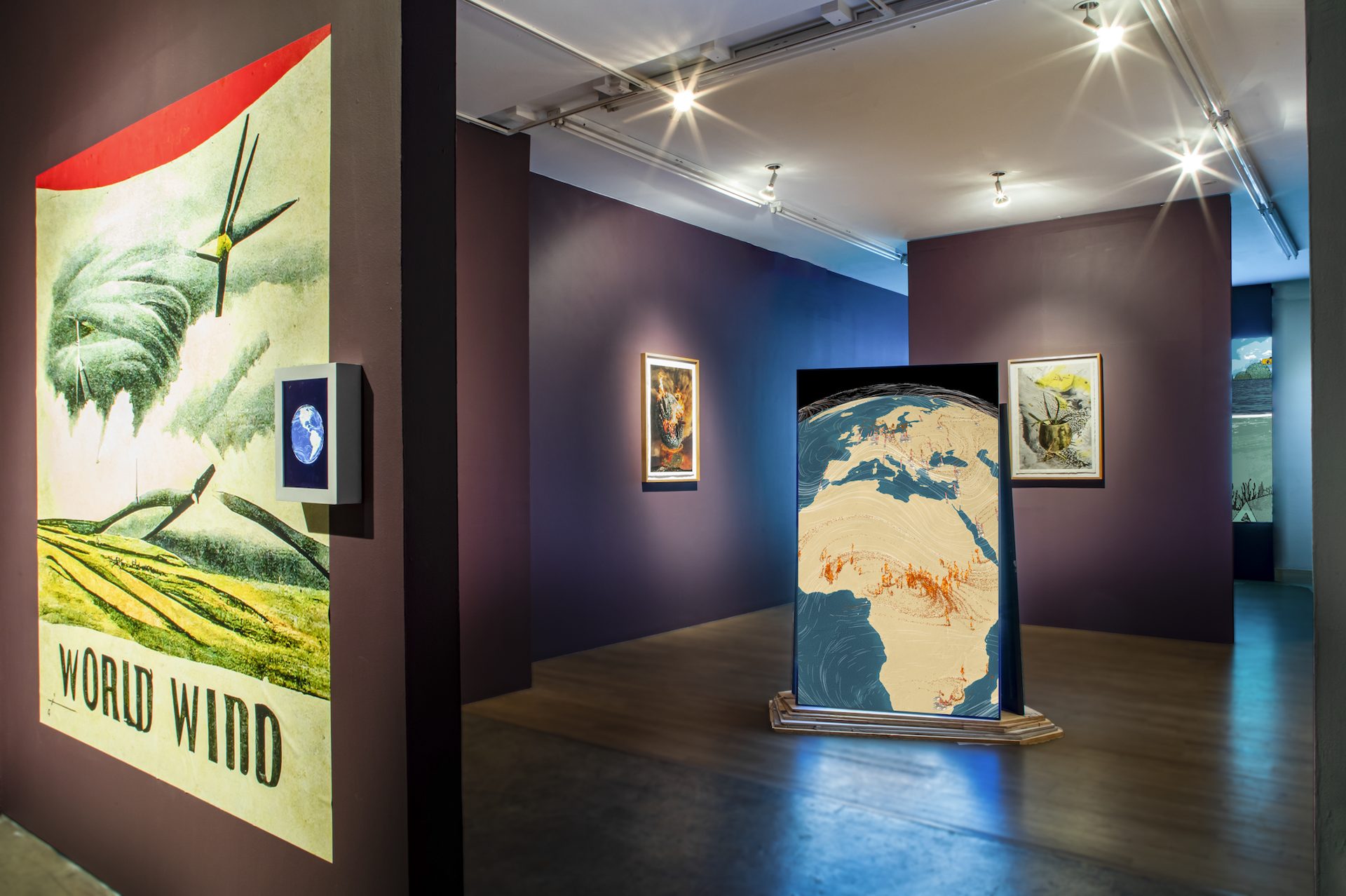World Wind
ITP Adjunct Professor Marina Zurkow in collaboration with ITP Alum James Schmitz
December 15, 2022–February 18, 2023
Opening Reception: Thursday, December 15, 6–8 PM
Winter Break: December 24, 2022 – January 3, 2023
Gallery Hours: Tuesday–Saturday: 11 AM–6 PM
World Wind is an exhibition featuring new artworks by Marina Zurkow and collaborative, generative pieces by Zurkow and James Schmitz. The title of the exhibition takes inspiration from a mural made by Zurkow in collaboration with Midjourney, an artificial intelligence software that creates images from textual descriptions. Through a prompt by the artist to the software—“World War II agitprop map of pollution and climate change”—World Wind incorporates AI’s perception of climate change with the artist’s guidance, editing, and direction. Zurkow positions iconography representative of ecological transformation within a style reminiscent of lithography and propaganda. Bordered by bold red and thick lettering, the work suggests both a reference to the past and a nod towards an inevitable future. Wind acts as a uniting force of this exhibition. Summoned through open source data and artificial intelligence, wind is a personification of global entanglement and a harbinger of change.
The Breath Eaters is an animated, custom software work by Zurkow and Schmitz that visualizes CO2 pollutants and other greenhouse gasses produced by wildfire and fossil fuel plant emissions. Inspired by a Midjourney image of a world map and presented as a live, three-channel generative composition, the work demonstrates how pollution is carried into the high atmosphere and across the globe on currents of wind. The Breath Eaters broadcasts real-time data from NASA’s fire detection systems, World Resources Institute’s global fossil fuel power plant database, and NOAA’s global forecast system. Zurkow expands on the notion of visualizing global emissions, writing “If carbon has been extracted and liberated to roam the globe on the winds, why is the world of beings (human, plant, animal) constrained by national boundaries, walled in and walled out? It is our hope that a near-live data stream of pollution’s transnationalism will give rise to empathy in viewers—this map can look very different with planetary action.” As the triptych globe turns within the gallery, visitors witness an immediate impression of global carbon pollution.
World Wind urges a conversation between individual and global moments, with Zurkow’s Crucible series touching on intimate aspects of this relationship. The porous connection between a lived experience to the far-reaching environment is portrayed through domestic, material manifestations. The artist’s own souvenirs, inherited objects, and hand-built ceramics interface with instances of environmental disaster and geo-planetary disruption. Crucible for erupting and disgorging depicts a hand-crafted bauble situated before a volcanic eruption; Crucible for surging, bursting, and spreading uses NOAA imagery of the Deepwater Horizon spill in the Gulf of Mexico as the grounding for a dead bee and found barnacles.
Does The River Flow Both Ways? carries this awareness into an alternate reality. Zurkow and Schmitz’s generative artwork explores a present-day Hudson River estuary in which happy social and biological ecosystems live in harmony; a place where humans can interact with the water in intimate ways and experience what is happening below its surface. The title questions whether such a techno-optimistic vision is viable. In good faith, the animated, software-driven work portrays a world in which renewables, public transport, water shipment, sensual freedom, and multi-species ecologies can coexist, even thrive, during a turbulent climactic period undergirded by a continued commitment to Capitalism. The animated elements emerge primarily in response to algorithmic probability as well as real-time weather and tide data.
Marina Zurkow
b.1962, New York, NY
Lives and works in the Mid-Hudson Valley, New York
Marina Zurkow is a media artist focused on near-impossible nature and culture intersections. She uses technologies including software, animation, audio, food, and biomaterials to foster intimate multispecies and geophysical connections. She works as a founding member of several collaborative initiatives, including Dear Climate, Making the Best of It: Nimble Foods for Climate Change, Climoji, and Investing in Futures.
Zurkow is a John Simon Guggenheim Memorial Fellow. She has also been granted awards from the New York Foundation for the Arts, New York State Council for the Arts, the Rockefeller Foundation, and Creative Capital. Currently, she is a fellow at Princeton University’s High Meadows Environmental Institute.
James Schmitz
b. 1975, New York
Lives and works in the Lower Hudson Valley, New York
Jim Schmitz is an artist and technologist exploring the expressive intersections of art, data, and science. He builds open source software tools and frameworks for artists, scientists, and the creative coding community. He is the author of the Python Processing framework py5.
Schmitz earned a master’s degree from the Interactive Telecommunications Program (ITP) at the Tisch School of the Arts, NYU, and was a Research Resident at ITP from August 2019 to August 2020.
